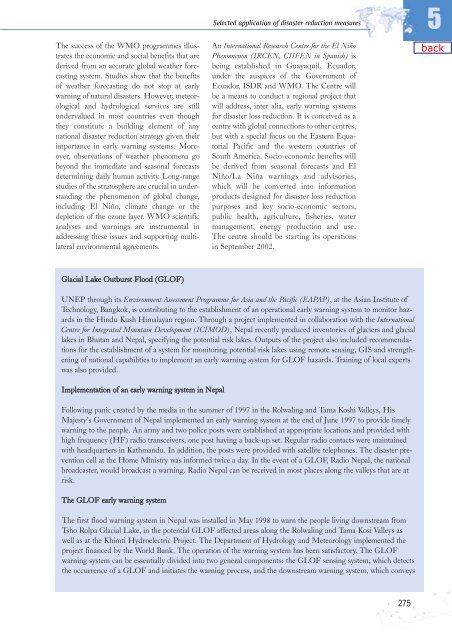Living with Risk. A global review of disaster reduction initiatives
Living with Risk. A global review of disaster reduction initiatives
Living with Risk. A global review of disaster reduction initiatives
You also want an ePaper? Increase the reach of your titles
YUMPU automatically turns print PDFs into web optimized ePapers that Google loves.
The success <strong>of</strong> the WMO programmes illustrates<br />
the economic and social benefits that are<br />
derived from an accurate <strong>global</strong> weather forecasting<br />
system. Studies show that the benefits<br />
<strong>of</strong> weather forecasting do not stop at early<br />
warning <strong>of</strong> natural <strong>disaster</strong>s. However, meteorological<br />
and hydrological services are still<br />
undervalued in most countries even though<br />
they constitute a building element <strong>of</strong> any<br />
national <strong>disaster</strong> <strong>reduction</strong> strategy given their<br />
importance in early warning systems. Moreover,<br />
observations <strong>of</strong> weather phenomena go<br />
beyond the immediate and seasonal forecasts<br />
determining daily human activity. Long-range<br />
studies <strong>of</strong> the stratosphere are crucial in understanding<br />
the phenomenon <strong>of</strong> <strong>global</strong> change,<br />
including El Niño, climate change or the<br />
depletion <strong>of</strong> the ozone layer. WMO scientific<br />
analyses and warnings are instrumental in<br />
addressing these issues and supporting multilateral<br />
environmental agreements.<br />
Selected application <strong>of</strong> <strong>disaster</strong> <strong>reduction</strong> measures<br />
An International Research Centre for the El Niño<br />
Phenomenon (IRCEN, CIIFEN in Spanish) is<br />
being established in Guayaquil, Ecuador,<br />
under the auspices <strong>of</strong> the Government <strong>of</strong><br />
Ecuador, ISDR and WMO. The Centre will<br />
be a means to conduct a regional project that<br />
will address, inter alia, early warning systems<br />
for <strong>disaster</strong> loss <strong>reduction</strong>. It is conceived as a<br />
centre <strong>with</strong> <strong>global</strong> connections to other centres,<br />
but <strong>with</strong> a special focus on the Eastern Equatorial<br />
Pacific and the western countries <strong>of</strong><br />
South America. Socio-economic benefits will<br />
be derived from seasonal forecasts and El<br />
Niño/La Niña warnings and advisories,<br />
which will be converted into information<br />
products designed for <strong>disaster</strong> loss <strong>reduction</strong><br />
purposes and key socio-economic sectors,<br />
public health, agriculture, fisheries, water<br />
management, energy production and use.<br />
The centre should be starting its operations<br />
in September 2002.<br />
5<br />
Glacial Lake Outburst Flood (GLOF)<br />
UNEP through its Environment Assessment Programme for Asia and the Pacific (EAPAP), at the Asian Institute <strong>of</strong><br />
Technology, Bangkok, is contributing to the establishment <strong>of</strong> an operational early warning system to monitor hazards<br />
in the Hindu Kush Himalayan region. Through a project implemented in collaboration <strong>with</strong> the International<br />
Centre for Integrated Mountain Development (ICIMOD), Nepal recently produced inventories <strong>of</strong> glaciers and glacial<br />
lakes in Bhutan and Nepal, specifying the potential risk lakes. Outputs <strong>of</strong> the project also included recommendations<br />
for the establishment <strong>of</strong> a system for monitoring potential risk lakes using remote sensing, GIS and strengthening<br />
<strong>of</strong> national capabilities to implement an early warning system for GLOF hazards. Training <strong>of</strong> local experts<br />
was also provided.<br />
Implementation <strong>of</strong> an early warning system in Nepal<br />
Following panic created by the media in the summer <strong>of</strong> 1997 in the Rolwaling and Tama Koshi Valleys, His<br />
Majesty’s Government <strong>of</strong> Nepal implemented an early warning system at the end <strong>of</strong> June 1997 to provide timely<br />
warning to the people. An army and two police posts were established at appropriate locations and provided <strong>with</strong><br />
high frequency (HF) radio transceivers, one post having a back-up set. Regular radio contacts were maintained<br />
<strong>with</strong> headquarters in Kathmandu. In addition, the posts were provided <strong>with</strong> satellite telephones. The <strong>disaster</strong> prevention<br />
cell at the Home Ministry was informed twice a day. In the event <strong>of</strong> a GLOF, Radio Nepal, the national<br />
broadcaster, would broadcast a warning. Radio Nepal can be received in most places along the valleys that are at<br />
risk.<br />
The GLOF early warning system<br />
The first flood warning system in Nepal was installed in May 1998 to warn the people living downstream from<br />
Tsho Rolpa Glacial Lake, in the potential GLOF affected areas along the Rolwaling and Tama Kosi Valleys as<br />
well as at the Khimti Hydroelectric Project. The Department <strong>of</strong> Hydrology and Meteorology implemented the<br />
project financed by the World Bank. The operation <strong>of</strong> the warning system has been satisfactory. The GLOF<br />
warning system can be essentially divided into two general components: the GLOF sensing system, which detects<br />
the occurrence <strong>of</strong> a GLOF and initiates the warning process, and the downstream warning system, which conveys<br />
275

















